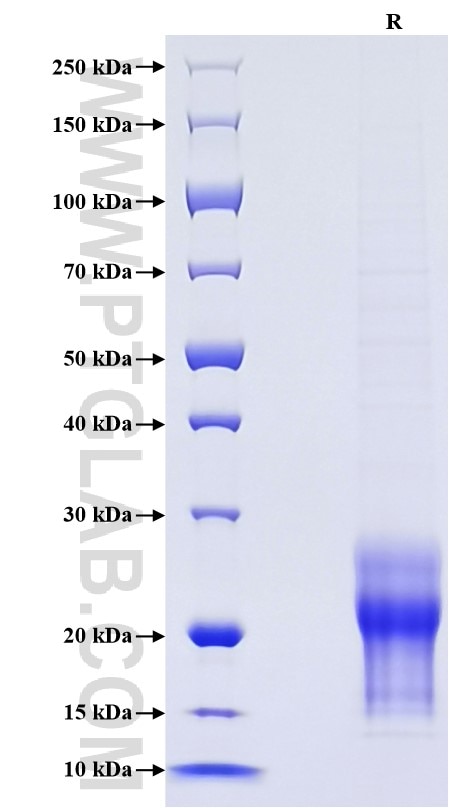Recombinant Human MCP-1/CCL2 protein (Myc Tag, His Tag)
Species
Human
Purity
>90 %, SDS-PAGE
Tag
Myc Tag, His Tag
Activity
not tested
Cat no : Eg31375
Validation Data Gallery
Product Information
| Purity | >90 %, SDS-PAGE |
| Endotoxin | <0.1 EU/μg protein, LAL method |
| Activity |
Not tested |
| Expression | HEK293-derived Human MCP-1 protein Gln24-Thr99 (Accession# P13500) with a Myc tag and a His tag at the C-terminus. |
| GeneID | 6347 |
| Accession | P13500 |
| PredictedSize | 13.7 kDa |
| SDS-PAGE | 15-27 kDa, reducing (R) conditions |
| Formulation | Lyophilized from 0.22 μm filtered solution in PBS, pH 7.4. Normally 5% trehalose and 5% mannitol are added as protectants before lyophilization. |
| Reconstitution | Briefly centrifuge the tube before opening. Reconstitute at 0.1-0.5 mg/mL in sterile water. |
| Storage Conditions |
It is recommended that the protein be aliquoted for optimal storage. Avoid repeated freeze-thaw cycles.
|
| Shipping | The product is shipped at ambient temperature. Upon receipt, store it immediately at the recommended temperature. |
Background
Monocyte chemotactic protein 1 (MCP1; also known as CCL2), is a chemokine that can be expressed in monocytes, macrophages, and endothelial cells, and belongs to the CC subfamily of chemokines. Chemokines are a superfamily of secreted proteins involved in immunoregulatory and inflammatory processes. Research has shown that the expression of MCP1 increases in the serum of patients with acute myocarditis. MCP1 is up-regulated in many types of CNS injury, including ischemia, hemorrhage, trauma, infection, hypoxia, and peripheral nerve axotomy. MCP1 has also been implicated in the pathogenesis of diseases characterized by monocytic infiltrates, such as psoriasis, rheumatoid arthritis, and atherosclerosis.
References:
1. Sørensen T. et al. (2004) Eur J Neurol. 11: 445-9. 2. Kusano KF. et al. (2004) Circ J. 68: 671-6. 3. Hayashida K. et al. (2001) Arthritis Res. 3: 118-26. 4. Dimitrijevic OB. et al. (2006) J Cereb Blood Flow Metab. 26:797-810. 5. Mahad DJ. et al. (2003) Semin Immunol. 15:23-32.
